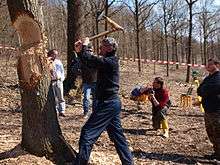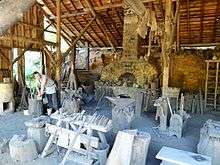Experimental archaeology


Experimental archaeology (also called experiment archaeology and experiential archaeology) is a field of study which attempts to generate and test archaeological hypotheses, usually by replicating or approximating the feasibility of ancient cultures performing various tasks or feats. It employs a number of methods, techniques, analyses, and approaches, based upon archaeological source material such as ancient structures or artifacts.[1]
It is distinct from uses of primitive technology without any concern for archaeological or historical study. Living history and historical reenactment, which are generally undertaken as a hobby, are the non archaeological person's version of this academic discipline.
One of the main forms of experimental archaeology is the creation of copies of historical structures using only historically accurate technologies. This is sometimes known as reconstruction archaeology or reconstructional archaeology; however, reconstruction implies an exact replica of the past, when it is in fact just a construction of one person's idea of the past; the more archaeologically correct term is a working construction of the past. In recent years, experimental archaeology has been featured in several television productions, such as BBC's "Building the Impossible"[2] and the PBS's Secrets of Lost Empires.[3] Most notable were the attempts to create several of Leonardo da Vinci's designs from his sketchbooks, such as his 15th century armed fighting vehicle.
Examples
A good example is Butser Ancient Farm in the English county of Hampshire which is a working replica of an Iron Age farmstead where long-term experiments in prehistoric agriculture, animal husbandry, and manufacturing are held to test ideas posited by archaeologists. In Denmark, the Lejre Experimental Centre carries out even more ambitious work on such diverse topics as artificial Bronze Age and Iron Age burials, prehistoric science and stone tool manufacture in the absence of flint.
Other examples include:
- The Kon-Tiki (1947), a balsa raft built by Thor Heyerdahl, sailed from Peru to Polynesia to demonstrate the possibility of cultural exchange between South America and the Polynesian islands.
- Attempts to transport large stones like those used in Stonehenge over short distances using only technology that would have been available at the time. The original stones were probably moved from Pembrokeshire to the site on Salisbury Plain.
- Since the 1970s the re-construction of timber framed buildings has informed understanding of early Anglo Saxon buildings at West Stow, Suffolk, England. This extensive program of research through experiment and experience continues today.
- The reconstruction of part of Hadrian's Wall at Vindolanda, carried out in limited time by local volunteers.
- Greek triremes have been reconstructed by skilled sailors from plans and archaeological remains and have been successfully tried at sea.
- Attempts to manufacture steel that matches all the characteristics of Damascus steel, whose original manufacturing techniques have been lost for centuries, including computational fluid dynamics reconstructions by the University of Exeter of the Sri Lanka furnaces at Samanalawewa, thought to be the most likely sources for Damascus steel.
- Experiments using reproduction bâtons de commandement as spear throwers.
- Guédelon Castle, a medieval construction project located in Treigny, France.
- Ozark Medieval Fortress, a sister project to Guédelon
- The Pamunkey Project - Dr. Errett Callahan led a series of extended Late Woodland living experiences in Tidewater Virginia.
- Marcus Junkelmann constructed Roman devices and gear for various museums. He also tested and analyzed them in various reenactments, among them a group of legionaries in full authentic gear crossing the Alps from Augsburg to Verona.
- Reconstruction of Galileo's Experiment: the inclined plane.[4]
- Reconstruction of Lomonosov's discovery of Venus's atmosphere.[5]
- Construction of a monastic community according to the ninth-century Plan of Saint Gall at Campus Galli.
- Janet Stephens utilizing her own skill as a hairdresser to reconstruct Roman-era hairstyles, rebutting previously held theories about single-prong pins being used to hold them in place.
Variations

Other types of experimental archaeology may involve burying modern replica artifacts and ecofacts for varying lengths of time to analyse the post-depositional effects on them. Other archaeologists have built modern earthworks and measured the effects of silting in the ditches and weathering and subsidence on the banks to understand better how ancient monuments would have looked. One example is Overton Down in England.
The work of flintknappers is also a kind of experimental archaeology as much has been learnt about the many different types of flint tools through the hands-on approach of actually making them. Experimental archaeologists have equipped modern professional butchers, archers and lumberjacks with replica flint tools to judge how effective they would have been for certain tasks. Use wear traces on the modern flint tools are compared to similar traces on archaeological artifacts, making probability hypotheses on the possible kind of use feasible. Hand axes have been shown to be particularly effective at cutting animal meat from the bone and jointing it.
Another field of experimental archaeology is illustrated by the studies of the stone flaking abilities of non- human primates. It has been demonstrated that bonobo ape are able to produce modified cores and flaked stones which are morphologically similar to early lithic industries in East Africa.[6]
Popular culture
The subject has proven popular enough to spawn several re-creation-type television shows:
- The 1978 BBC TV series Living in the Past re-created life in an Iron Age village with 15 volunteers over a period of 13 months.
- Discovery Channel's I, Caveman[7] and I, Caveman : The Great Hunt [8]
- Discovery Channel's The Colony[9] seasons 1 and 2 showed aspects of experimental archaeology
- Discovery Channel's MythBusters often conduct experimental archaeology to test the capability of mythical ancient weapons including Archimedes' death ray, and the tree cannon, as well as testing the capabilities of known weapons including the hwacha and the effects of cannonballs and splintering.
- The BBC has several re-creation farm series, including Tudor Monastery Farm, Tales from the Green Valley, Victorian Farm, Edwardian Farm, and Wartime Farm.
- BBC Two has a series on the construction of Guédelon Castle: Secrets of the Castle.
See also
Notes
- ↑ Experimental archaeology is "Within the context of a controllable imitative experiment to replicate past phenomena in order to generate and test hypotheses to provide or enhance analogies for archaeological interpretation" (Mathieu, 12)
- ↑ http://www.imdb.com/title/tt0369083/
- ↑ http://www.pbs.org/wgbh/nova/lostempires/
- ↑ http://www.u-picardie.fr/~dellis/Documents/PhysicsEducation/Reconstruction%20of%20Galileo%20Galilei.pdf
- ↑ http://arxiv.org/abs/1208.5286
- ↑ Schick, Kathy; Toth, Nicholas; Garufi, Gary; Savage-Rumbaugh, E. Sue; Rumbaugh, Duane; Seveik, Rose (1999). "Continuing Insestigations into the Stone Tool-making and Tool-using Capabilities of a Bonobo (Pan panisus)". Journal of Archaeological Sciences. 26 (7): 821–832. doi:10.1006/jasc.1998.0350.
- ↑ http://www.incubatortv.com/i-caveman/
- ↑ http://www.amazon.com/I-Caveman-The-Great-Hunt/dp/B005RUXET2
- ↑ http://dsc.discovery.com/tv/colony/about/colony.html
References
- Ascher, Robert (1961): Experimental archeology. in: American Anthropologist (Menasha) 63, 4: pp 793–816.
- Ascher, Robert (1970): Cues 1: design and construction of an experimental archaeological structure. in: American Antiquity (Washington) 35, 2: pp 215–216.
- Coles, John Morton (1979), Experimental archaeology, London a.o.: Academic Press, ISBN 0-12-179750-3 / ISBN 0-12-179752-X, 274 pp. Republished 2010, ISBN 978-1-932846-26-3.
- Ingersoll, Daniel W., Yellen, John E., Macdonald, William (editors), (1977), Experimental archaeology, New York, ISBN 0-231-03658-2, 432 pp.
- Mathieu, James R. (editor), (2002), Experimental archaeology, replicating past objects, behaviors and processes, BAR International Series 1035, Oxford, ISBN 1-84171-415-1.
- Reynolds, Peter J. (n.y.): The Nature of Experiment in Archaeology.
- Stone, Peter; Planel, Phillipe, (1999), The Constructed past. Experimental archaeology, education and the public, Routledge: One World Archaeology Series, ISBN 0-415-11768-2, 296 pp.
- Tringham, Ruth (1978), Experimentation, ethnoarchaeology, and the leapfrogs in archaeological methodology. in: Gould, Richard A. (editor): Explorations in ethnoarchaeology. Albuquerque, pp 169–199.
- Verhoeven, J.D., Pendray, A.H., Dauksch, W.E., (1998), The Key Role of Impurities in Ancient Damascus Steel Blades, in: JOM, 50 (9) (1998), pp. 58–64.
External links
| Wikimedia Commons has media related to Experimental archaeology. |
- Butser Ancient Farm, Hampshire, UK
- Handshouse Studio, Norwell, MA
- The Lejre Land Of Legends, Denmark
- EXARC, the International association of Archaeological Open Air Museums and Experimental Archaeology
- EXAR the European Association for the advancement of archaeology by experiment
- The University of Exeter MA in experimental archaeology
- The University of Sheffield MSc in experimental archaeology
- West Stow Anglo-Saxon Village